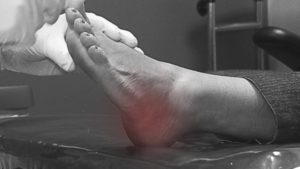Did you know that ankle sprains account for 16% to 40% of sports related injuries?
Soccer players and basketball players often struggle with foot twists, ligament stretches, and severe foot and ankle fractures. Ankle and foot motion is crucial for athletes, and atypical ankle sprain can take around 6 weeks to heal completely. Moreover, according to studies, there is a high prevalence of injury recurrence. Therefore, it is important to know everything about ankle sprains and have a strategy in place to prevent the injuries.
If you are an athlete or spend a lot of time in sports activities, then this post is going to be really helpful for your ankle health. Let’s discuss some important facts about foot and ankle pain. We will discuss the causes of pain and the most useful techniques to avoid sports injuries.

- Sports injuries:Tennis, soccer, basketball and running account for the top 4 activities that lead to sprained ankles and fractures. Landing on an uneven surface is the most common reason behind ankle injuries.
- The most severely affected parts are the Achilles tendon and plantar fascia.
- 49% of injuries occur to those who run more than 50 miles per week
- 15% of sports related ankle injuries are stress fractures
- An ankle sprain is the most common sports injury reported by soccer players
- Causes of ankle twists: As mentioned above, ankle sprains are common and account for the biggest reason behind sports injuries.
- Every day, more than 25,000 ankles are sprained or twisted.
- All of them are not because of sports activities, some injuries are due to ill-fitting shoes.
- Your ankle is most likely to twist inwardwhen the foot functions are not supported by the right shape and size of footwear.
Our ankles go through a lot every day, therefore you must pay attention to the type of footwear you choose. It is highly recommended to consult a podiatrist for footwear guidance in the case of physically strenuous activities.
- Classic signs of ankle pain: A higher percentage of people with a sprained ankle report the three most common signs:
- pain in the ankle joint,
- inflammation
Ankle bruising and inflammation occur due to internal bleeding. When a twisted ankle is sprained, the connecting ligaments also get injured and create mobility issues.
- Diagnosis and treatment of an injured ankle: Your ankle must be assessed immediately by a qualified foot doctor. The treatment plan depends on the severity of the problem. However, one must not wait for the pain to subside on its own. Immediate medical assistance is necessary to avoid severe complications to the connecting ligaments. An injured ankle can be treated with:
- Rest, Ice, Compression and Elevation (RICE)
- Anti-inflammatory medications
- Walking aids and foot braces
- Manual therapy
- Exercise therapy
- Surgery (in refractory cases)
Resist the urge to apply anything hot to the affected area. Experts suggest that applying ice packs is effective in reducing swelling and pain. A sprained ankle can only be treated by a medical professional. In some cases, immobilization through a cast or a brace is also required to treat the affected ankle joints
Besides, patience is the key; twisted ankles take time to regain their full functionality. If you are an athlete, you must consult a podiatrist for the best suited rehabilitation exercise and therapies to reduce the risk of further ankle injuries or fractures.
- Prevention: No sports enthusiast would want to be offtheground for 6 weeks due to ankle sprains or fractures. Therefore, the key prevention tips must be followed rigorously.
- Athletic shoes: Wearing sport specific shoes is very important to avoid ankle sprains. Consult with a professional to pick the right type of heel counter and cushioning platform for your shoes.
Runners must replace their shoes every six months to ensure that the shoes are supporting muscle strength and mobility.
- Warm up: Always warmup the muscles with a light stretch for at least 2 to 3 minutes prior to training.
- Muscle conditioning: If you want to increase the time spent on sports activities, it must be a gradual process conducted on a weekly basis. Give your muscles enough time to condition to ensure the risk of sprains and stress fractures is minimal.
- Training surface: Most strains and sprains occur by landing on an uneven surface. Therefore, athletes must pick the training surfaces carefully. Avoid stepping on rocky surfaces or gradually increase the training intensity if you like to train on hills or dirt roads.
- Training intensity: Never ignore the slightest of discomfort because if left untreated the sprain can lead to weeks or even months of rehabilitation therapy. Always listen to your body and modify the activity until the discomfort is diminished.
Conclusion
Ankle twists and sprains can be simple or complex. However, athletes are advised to always listen to their bodies to ensure that their training never stops due to an injury. Pick the recommended type of shoes, be mindful of the training intensity and always consult a podiatrist. Routine appointments with a foot doctor are helpful in improving your performance standards. A podiatrist can conduct gait analysis and an in-depth biomechanical assessment to help reduce the risk of sports related injuries.
Consult with the team of expert podiatrists at Orange County Foot and Ankle Group to ensure the optimum functioning of your feet. These experts have years of experience in sports injuries treatment and their guidance can be great for footwear modification and injury prevention.




Comments